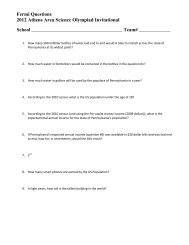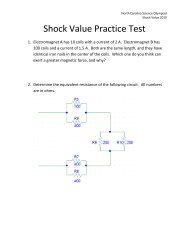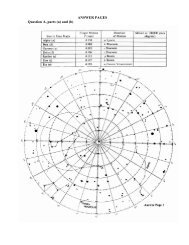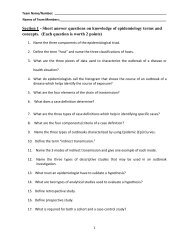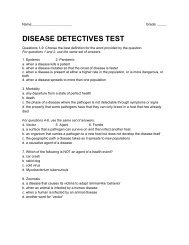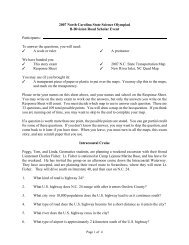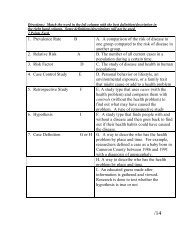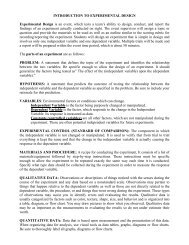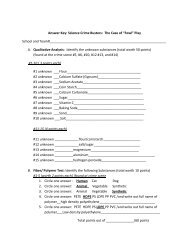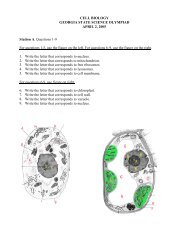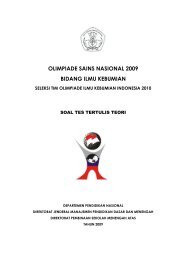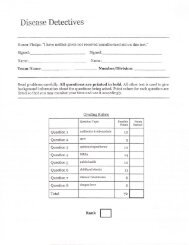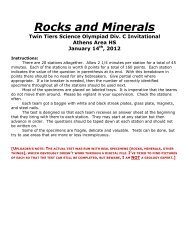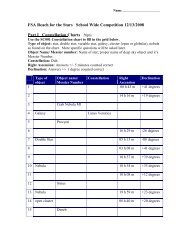Directions: Answer each of the following problems. Record your ...
Directions: Answer each of the following problems. Record your ...
Directions: Answer each of the following problems. Record your ...
You also want an ePaper? Increase the reach of your titles
YUMPU automatically turns print PDFs into web optimized ePapers that Google loves.
Science Olympiad Regional<br />
February 2012<br />
Chem Lab Station 1<br />
Oxidation/Reduction<br />
<strong>Directions</strong>: <strong>Answer</strong> <strong>each</strong> <strong>of</strong> <strong>the</strong> <strong>following</strong> <strong>problems</strong>. <strong>Record</strong> <strong>your</strong> responses<br />
on <strong>the</strong> Team <strong>Answer</strong> Sheet. Each problem or part <strong>the</strong>re<strong>of</strong> is worth 3 points<br />
unless o<strong>the</strong>rwise noted.<br />
You are provided with <strong>the</strong> <strong>following</strong> materials:<br />
<br />
<br />
<br />
<br />
<br />
<br />
<br />
<br />
Lemon in a petri dish with two slices in its peel<br />
A pencil, sharpened on both ends, exposing its carbon (graphite) core<br />
An iron nail (or o<strong>the</strong>r sample <strong>of</strong> iron metal)<br />
A magnesium strip<br />
A zinc strip<br />
Voltmeter (or equivalent instrument for measuring voltage)<br />
Alligator clips to connect <strong>the</strong> voltmeter probes to electrodes<br />
Optional - piece <strong>of</strong> steel wool or sandpaper to clean <strong>the</strong> metal electrodes<br />
1. Place a combination <strong>of</strong> pencil, iron, magnesium, and zinc electrodes in different<br />
combinations into <strong>the</strong> slits in <strong>the</strong> lemon and use <strong>the</strong> voltmeter to measure <strong>the</strong><br />
voltage <strong>of</strong> <strong>each</strong> combination. Organize <strong>your</strong> data in a table on <strong>your</strong> answer sheet.<br />
Use <strong>your</strong> data to answer <strong>the</strong> <strong>following</strong> questions:<br />
2. When C is paired with Fe, write <strong>the</strong> half reaction that occurs at <strong>the</strong> cathode.<br />
3. When C is paired with Fe, write <strong>the</strong> half reaction that occurs at <strong>the</strong> anode.<br />
4. When Zn is paired with Fe, write <strong>the</strong> half reaction that occurs at <strong>the</strong> cathode.<br />
5. When Zn is paired with Fe, write <strong>the</strong> half reaction that occurs at <strong>the</strong> anode.<br />
6. Rank <strong>the</strong> 3 metals according to chemical activity from highest to lowest. (A high<br />
voltage when paired with <strong>the</strong> carbon electrode indicates high chemical activity)<br />
7. Using zinc and copper electrodes <strong>of</strong> high purity in an especially ripe lemon at room<br />
temperature produces 0.9 V and 0.3 mA (milliamperes). Considering that <strong>the</strong> power<br />
<strong>of</strong> a voltaic cell is measured in Watts, which is calculated by multiplying volts x<br />
amps, what is <strong>the</strong> power <strong>of</strong> this voltaic cell?<br />
8. A low power LED (Light Emitting Diode) requires 80 mW to properly work. How<br />
many lemon zinc-copper lemon cells described in problem #7 would be needed to<br />
be connected in series to power this LED? (Round <strong>your</strong> answer <strong>of</strong>f to <strong>the</strong> nearest<br />
whole number)
For <strong>problems</strong> 9 - 11 , complete and balance <strong>each</strong> half reaction. In<br />
<strong>each</strong> case, indicate whe<strong>the</strong>r oxidation or reduction occurs.<br />
9. Co 2+ (aq) → Co 3+ (aq)<br />
10. ClO 3<br />
-<br />
(aq) → Cl - (aq) (acidic solution)<br />
11. SO 3<br />
2-<br />
(aq) → SO 4<br />
2-<br />
(aq) (basic solution)<br />
For problem #12, complete and balance <strong>the</strong> redox reaction.<br />
12. Pb(OH) 4<br />
2-<br />
(aq) + ClO - (aq) → PbO 2(s) + Cl - (aq) (basic solution)<br />
Use <strong>the</strong> table <strong>of</strong> Standard Electrode Potentials to answer <strong>the</strong> <strong>following</strong><br />
questions on <strong>the</strong> Galvanic Cell (Problems 13-22 are worth 2 pts. <strong>each</strong>):<br />
Cu<br />
Cr<br />
1 M Cu 2+ 1 M Cr 3+<br />
13. Write <strong>the</strong> oxidation half reaction for this cell.<br />
14. Write <strong>the</strong> reduction half reaction for this cell.<br />
15. Write <strong>the</strong> net ionic reaction for this cell.<br />
16. Identify <strong>the</strong> substance being oxidized<br />
17. Identify <strong>the</strong> substance being reduced.<br />
18. Identify <strong>the</strong> oxidizing agent.<br />
19. Identify <strong>the</strong> reducing agent.<br />
20. On <strong>your</strong> answer sheet, place an arrow over <strong>the</strong> voltmeter to indicate<br />
<strong>the</strong> direction <strong>of</strong> electron flow.<br />
21. Which electrode is gaining in mass?<br />
22. What is <strong>the</strong> E o for this cell?
23. A battery consists <strong>of</strong> one or more voltaic cells. One <strong>of</strong> <strong>the</strong> most<br />
common and useful batteries is <strong>the</strong> lead storage battery, also known as<br />
a car battery. It consists <strong>of</strong> six cells, <strong>each</strong> producing 2 V. The electrode<br />
reactions that occur during discharge are as follows:<br />
2-<br />
Cathode: PbO 2(s) + SO 4 (aq) + 4H + (aq) + 2 e - → PbSO 4(s) + 2 H 2 O (l)<br />
2-<br />
Anode: Pb (s) + SO 4 (aq) → PbSO 4(s) + 2 e -<br />
(a) Write a complete, balanced equation for <strong>the</strong> reaction that occurs within<br />
a lead storage battery.<br />
(b) Write <strong>the</strong> balanced oxidation half reaction.<br />
(c) Write <strong>the</strong> balanced reduction half reaction.<br />
(d) Based upon <strong>the</strong> oxidation and reduction half reactions, write <strong>the</strong><br />
balanced redox reaction.<br />
(e) What is <strong>the</strong> total voltage <strong>of</strong> a lead storage battery?<br />
(f) One advantage <strong>of</strong> a lead storage battery is that it can be recharged.<br />
Write <strong>the</strong> complete, balanced equation for <strong>the</strong> reaction that occurs<br />
while a lead storage battery is being recharged.<br />
(g) Old or defective car batteries may leak fluid which is very dangerous to<br />
touch. Identify this liquid.<br />
For problem 24, answer <strong>the</strong> <strong>following</strong> questions regarding <strong>the</strong> electrochemical<br />
cell shown.<br />
(a) Write <strong>the</strong> balanced net-ionic equation for <strong>the</strong> spontaneous reaction that<br />
occurs as <strong>the</strong> cell operates.<br />
(b) If <strong>the</strong> cell voltage is +1.20 V, what is <strong>the</strong> E o for <strong>the</strong> oxidation <strong>of</strong> Cd?<br />
(c) In which direction do anions flow in <strong>the</strong> salt bridge as <strong>the</strong> cell<br />
operates?<br />
(d) If 10.0 mL <strong>of</strong> 3.0-molar AgNO 3 solution is added to <strong>the</strong> half-cell on <strong>the</strong><br />
right, what will happen to <strong>the</strong> cell voltage?<br />
(e) If 1.0 gram <strong>of</strong> solid NaCl is added to <strong>each</strong> half-cell, what will happen to<br />
<strong>the</strong> cell voltage?
Station 1 Multiple Choice: <strong>Record</strong> <strong>the</strong> letter <strong>of</strong> <strong>the</strong> best answer on <strong>your</strong> answer sheet.<br />
25.<br />
30.<br />
26.<br />
27.<br />
31.<br />
28.<br />
32.<br />
29.



